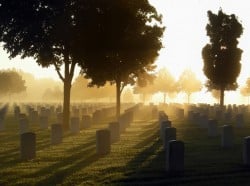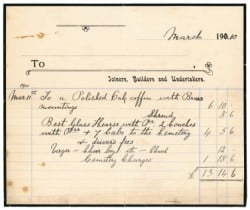When you plan a funeral for a loved one, chances are you will be in contact with the funeral director and/or the funeral assistant for most of the time. These individuals serve as the point of communication for almost all your burial and cremation needs, making it easy for you to form a personal connection and ensure that you receive the high level of service you deserve. (more…)
Posts Tagged ‘funeral director’
The Funeral Home Staff
Tuesday, April 5th, 2016Top Movies about Funerals
Thursday, May 7th, 2015If you look at the proportion of movies about weddings compared to the proportion of movies about funerals, you’ll find that people are much more interested in watching the celebration of love rather than the celebration of death. While this isn’t really surprising (traditionally, the sad movies we love to watch focus more on the character’s journey than the aftermath of loss), it is interesting to note that funeral-oriented movies are on the rise.
Whether you’re in the mood for a funeral-related movie with humor to pick you up, or if you need something to remind you that everyone goes (more…)
How to Choose a Funeral Director
Wednesday, December 10th, 2014 When you’re choosing a funeral home to help you with funeral planning, you’re not just considering which facility is best—you’re also interviewing funeral directors. Because you’ll be relying on one individual for so much of your support and decision-making, it’s important that you feel a connection with your funeral director built on trust and understanding. Although you probably won’t have time to call and get to know every funeral director in the event of a sudden death, you can take a few minutes to chat with them to get a feeling for who you’d like to work with.
When you’re choosing a funeral home to help you with funeral planning, you’re not just considering which facility is best—you’re also interviewing funeral directors. Because you’ll be relying on one individual for so much of your support and decision-making, it’s important that you feel a connection with your funeral director built on trust and understanding. Although you probably won’t have time to call and get to know every funeral director in the event of a sudden death, you can take a few minutes to chat with them to get a feeling for who you’d like to work with.
What Does a Funeral Director Do?
What to Do When Your Family Doesn’t Like Your Funeral Plans
Sunday, May 25th, 2014 Like part of a growing trend of Americans, you’ve pre-arranged your funeral to save your family from heartache after your death. You made the decision between cremation and burial, and set aside the appropriate funds to cover the entire ceremony. Now all that rests between you and completing your advance funeral arrangements is sitting down to inform your family of the details.
Like part of a growing trend of Americans, you’ve pre-arranged your funeral to save your family from heartache after your death. You made the decision between cremation and burial, and set aside the appropriate funds to cover the entire ceremony. Now all that rests between you and completing your advance funeral arrangements is sitting down to inform your family of the details.
While most families appreciate the time, effort, and money that goes into advance funeral planning, this isn’t always the case. If you deviate from tradition or plan for something out of the ordinary, you may find yourself facing a family who not only disagrees with your funeral plans, but who are honestly hurt by the decisions you have made.
5 Questions to Ask Before You Start Funeral Planning
Monday, April 14th, 2014 Once you’ve made the decision to begin funeral planning, it’s easy to become overwhelmed by all the information and options out there. Choosing cremation vs burial, picking between dozens of local funeral homes, considering funeral insurance vs a pre-plan funeral package…these are just a few of the options that pop up in the beginning of your search.
Once you’ve made the decision to begin funeral planning, it’s easy to become overwhelmed by all the information and options out there. Choosing cremation vs burial, picking between dozens of local funeral homes, considering funeral insurance vs a pre-plan funeral package…these are just a few of the options that pop up in the beginning of your search.
Because few purchases will ever be more personal than the ones you make regarding your own death, it’s important to take a deep breath and relax as you move forward. Although time is one of the few things none of us has an unlimited amount of, you should never plan a funeral in haste. It’s too easy to overpay or buy services you don’t need if you feel pressured to make immediate decisions.
Funeral Luncheon Etiquette and Advice
Sunday, December 15th, 2013 After the funeral planning has come to an end and the family gathers to say goodbye to the deceased, it’s time for the funeral luncheon to start. Because most funerals take place during the morning (or in the early afternoon), it’s common for the deceased’s family to hold an informal luncheon afterward, in which guests can enjoy a light repast and share their grief.
After the funeral planning has come to an end and the family gathers to say goodbye to the deceased, it’s time for the funeral luncheon to start. Because most funerals take place during the morning (or in the early afternoon), it’s common for the deceased’s family to hold an informal luncheon afterward, in which guests can enjoy a light repast and share their grief.
Although this type of after-funeral memorial party isn’t a required tradition, it’s a good idea to brush up on your funeral lunch etiquette before you arrive.
Funeral Planning: Winter Burials
Saturday, November 2nd, 2013 The behind-the-scenes aspect of the funeral industry is one that remains a mystery to many people. Often because we don’t care to know the gritty details of death and burial, and sometimes because we aren’t sure what kinds of questions to ask, or what funeral directors and funeral homes do to care for your loved ones isn’t always widespread knowledge.
The behind-the-scenes aspect of the funeral industry is one that remains a mystery to many people. Often because we don’t care to know the gritty details of death and burial, and sometimes because we aren’t sure what kinds of questions to ask, or what funeral directors and funeral homes do to care for your loved ones isn’t always widespread knowledge.
One of the often overlooked details of burial is what happens during the winter months in colder climates, when the ground is frozen. Frozen turf is difficult (and expensive) to dig into, especially at the depth required for human burial. When combined with other harsh winter hazards like unplowed roads, unsafe driving conditions, and the snowfall on the cemetery itself, the results are not conducive to immediate burial. That’s why many of the colder states (think Alaska and North Dakota) have contingency plans in place.
Burial in Cold Climates
Few states have laws in place to regulate winter burials. Some, like Minnesota, Wisconsin, and New York, require burial in the winter regardless of weather conditions. Others might allow you to opt for a “cold storage” option to avoid the heavier fees of opening a grave in the winter.
In this instance, “cold storage” isn’t as terrible as it seems. Funeral directors may keep bodies in cemetery crypts or inside the funeral home until a date when the ground thaws enough to allow for burial. This practice is one that has existed for hundreds of years. If winter burials are difficult in our age of backhoes and jackhammers, it’s easy to imagine how hard it would have been in centuries past. And because older generations didn’t have access to morgues and other indoor body storage options, it was common to keep bodies in a crypt until spring.
Funeral Cost Calculator
Friday, September 6th, 2013 Funeral costs are a real concern for most families facing the death and burial of a loved one. At a time when stress and anxiety are already higher than average, knowing that you will be expected to pay out thousands of dollars to provide a fitting farewell can prove difficult.
Funeral costs are a real concern for most families facing the death and burial of a loved one. At a time when stress and anxiety are already higher than average, knowing that you will be expected to pay out thousands of dollars to provide a fitting farewell can prove difficult.
While more and more families are preparing for this eventuality with funeral pre-paid packages, there are options for those who have not planned ahead. In addition to financing a funeral, you can manage funeral costs by comparison shopping, selecting lower-cost burial alternatives, and coordinating services at the funeral home of your choice.
Online Funeral Planner Assistance
If you are preparing to plan a funeral, we suggest following this guide to estimate costs and come up with the best options for your family. Losing a loved one will always be difficult—and financing a funeral is rarely something anyone looks forward to—but with the right resources and support, you can come up with a beautiful funeral that won’t break the bank.
Are There Differences between Male and Female Funeral Directors?
Thursday, August 29th, 2013 The funeral planning industry has long been considered a male-dominated profession. From the funeral directors who greet you at the door to the behind-the-scenes morticians who prepare your loved one for a final viewing, men have made up the majority of funeral service workers for quite some time.
The funeral planning industry has long been considered a male-dominated profession. From the funeral directors who greet you at the door to the behind-the-scenes morticians who prepare your loved one for a final viewing, men have made up the majority of funeral service workers for quite some time.
Historically, caring for the dead has been the responsibility of women. As caretakers of the home (where most body preparation took place during the pre-Victorian eras), women were responsible for washing and dressing the body, and placing it in a shroud. From there, men took over. Building coffins, carrying the body, and the actual burial was men’s work. In fact, burial was considered such a “male” issue that in many cultures, women weren’t even allowed to attend the funerals or participate in the procession.
What You Should Know about Funeral Makeup
Tuesday, May 7th, 2013 When you opt for a body viewing or an open casket during funeral planning, there is quite a bit of preparation that has to go in to making the body of the deceased presentable. In addition to techniques like embalming, it is the job of a funeral makeup artist to provide a serene, lifelike pallor to the deceased’s face and hands.
When you opt for a body viewing or an open casket during funeral planning, there is quite a bit of preparation that has to go in to making the body of the deceased presentable. In addition to techniques like embalming, it is the job of a funeral makeup artist to provide a serene, lifelike pallor to the deceased’s face and hands.
Most people accept funeral makeup as part of the funeral planning process, and one of the many items you’ll be asked to bring (in addition to the clothes you wish the deceased to be buried in as well as jewelry and other personal effects for display) is a photograph of the deceased that depicts her favored type of makeup. In some cases, you may even bring in the actual makeup, since it can be used to recreate the deceased’s normal appearance.




